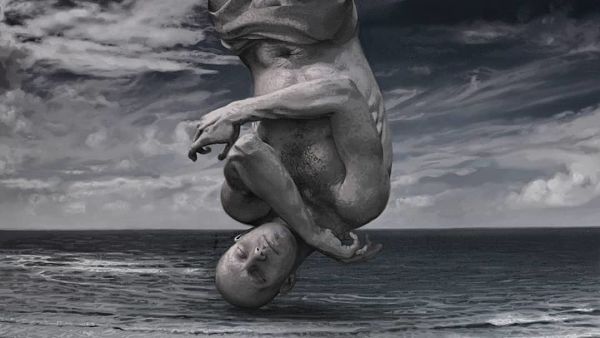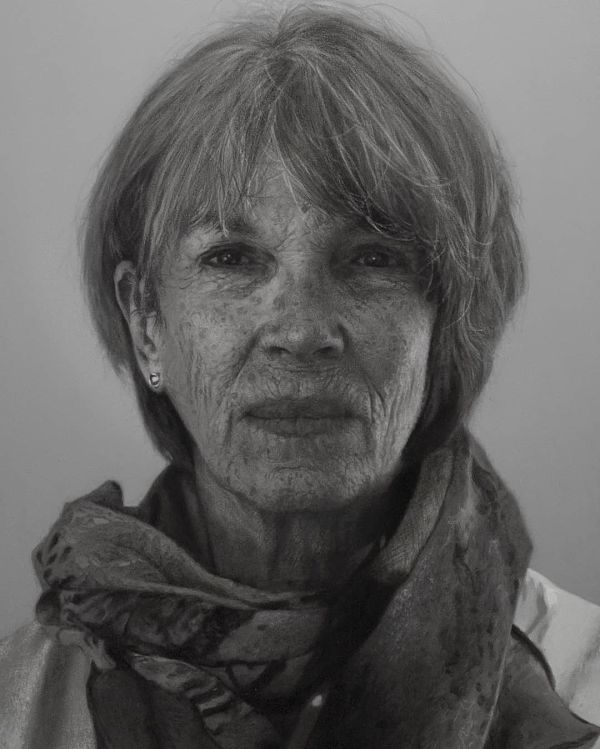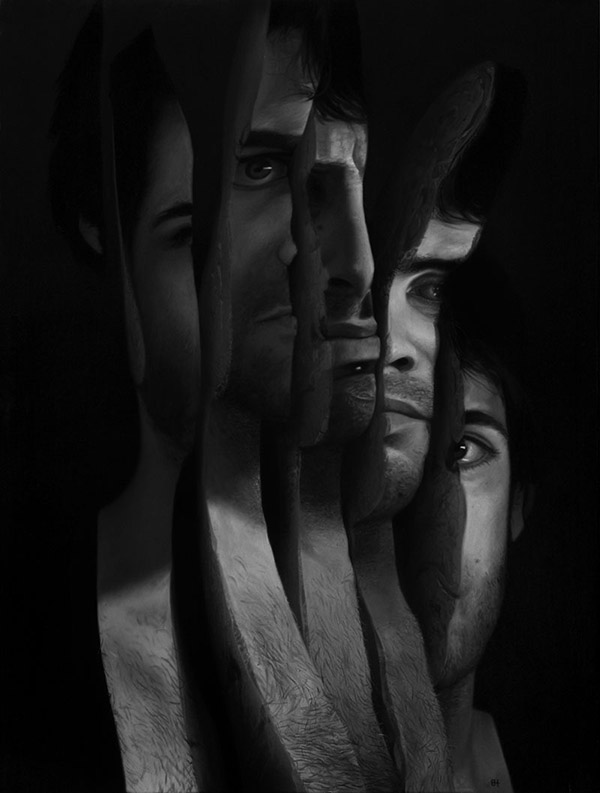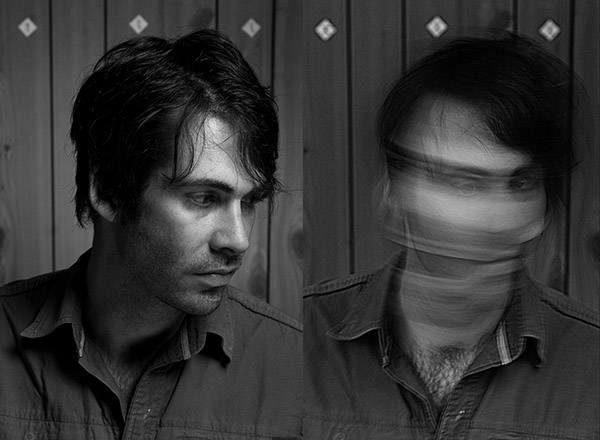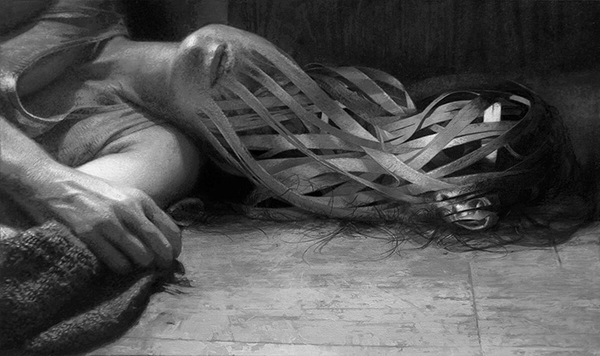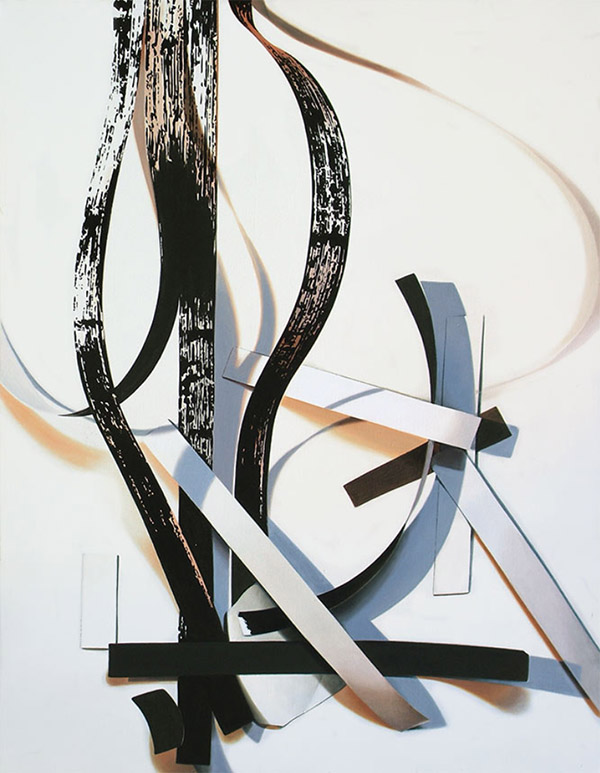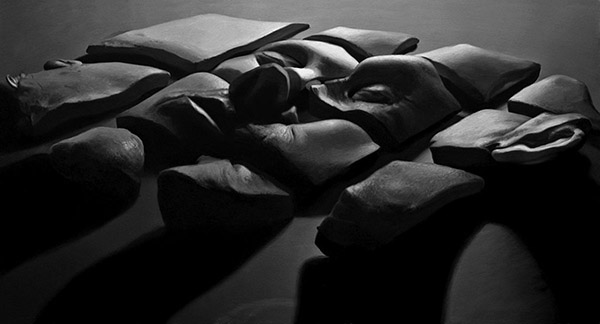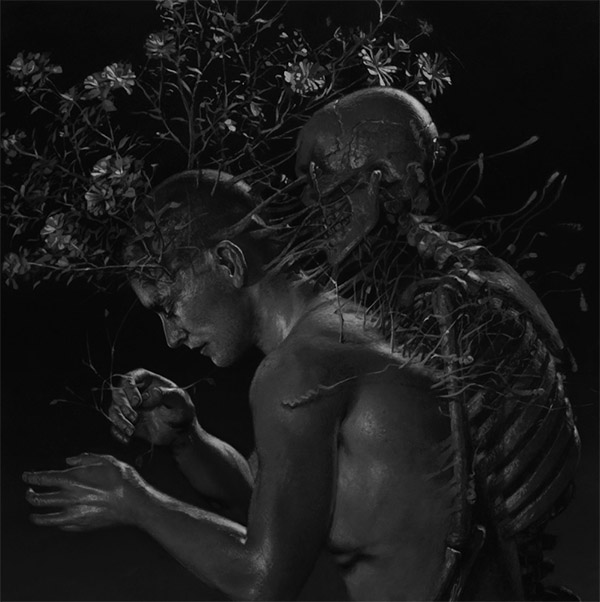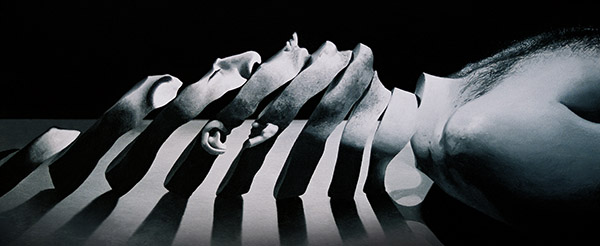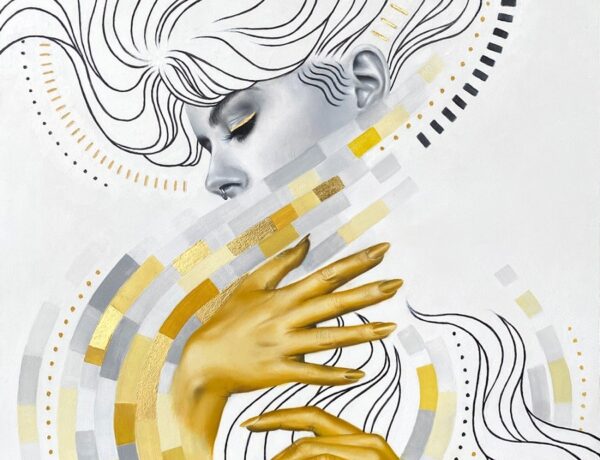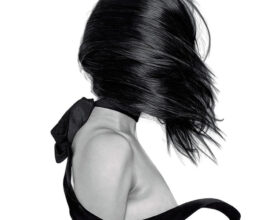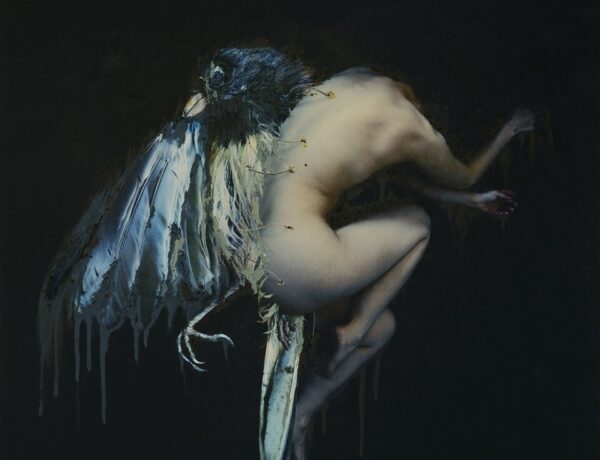Strips of fabric swerve and weave, slices of skin lay dormant and heavy. The hyperrealism of Ben Howe may look surreal, but if one were to look at reality as the shifting, organic and emotive perspective that philosophies of existence are actually based on, perhaps his paintings wouldn’t seem so hypnagogic. Ben Howe’s own experiences have seen tempestuous days making his creations have a depth of concept that sparks visceral connections with his audiences.
He was kind enough to share more about his past, processes, and paintings… we hope you enjoy!
A well-engineered image is able to quietly seep into the collective psyche.
Interview conducted in conjunction with Ben Howe’s editorial in Issue 20 of Beautiful Bizarre Magazine.
Realist painting is burdened with history, and therefore with certain expectations and biases. Everyone believes they are an authority because the ‘painting’ has always been there, along with drawing and mark-making. It’s very existence is in our DNA. This often makes it an unpopular focus for academics who seek out the overtly new or unexplained.
Can you tell us a bit about your background as an artist? What is your first memory of an artistic experience, and why were you drawn to painting?
I remember being taken to the national gallery often as a child and being haunted by the abstracted works and a selection of masks from South America. I would run through a certain room with my hands over my face so I didn’t have to look at them. Ironically, with avoidance, they became exaggerated– these things whose presence I could sense but couldn’t see. I’ve later become obsessed with the reality that sits just out of view, beyond our everyday field of perception. Strangely, although I’m mostly a painter, it’s always been the sculptors that really captured my attention. I used to have a recurring dream where two huge sculptures would follow me… a Henry Moore and a Rodin. There was something about their other worldly reality that has stuck with me; they existed both physically and my dreams: still and inevitable. They had the power and weight of mountains.
Whenever I am interviewed, I get the chance to look back over my work and see it with some distance. And I think the influence of these early experiences is evident – the paintings are indeed sculptural: solid, without time and emblematic. It also seems that I’ve been channeling these intangible thoughts since the beginning, exploring the penumbra, that fuzzy place between light and shadow, reality and imagination. I’ve been an artist for most of my adult life. When I was young, due to a combination of dyslexia and introspection, I found I was more comfortable communicating my ideas visually.
I often create dioramas and sculptures, which are then photographed and rendered in paint, using a technique that appears photographic from a distance, yet becomes more abstracted and painterly with proximity. Repetition, miniaturization, and fluctuations between representation and abstraction are used to activate links between the body, movement and memory.
The paintings you do are examples of highly skilled hyperrealism. Beyond being born with innate talent, how did you flourish and practice within the realm of realism? Is art education important to you?
I don’t think I was especially talented to begin with. I kept to myself, read a lot of books and did a lot of drawing. If you develop the curiosity and skills early on, possibly to the detriment of other abilities, then anyone can be an artist. It becomes your way of speaking. I think you also need a huge amount of resilience and persistence to overcome the failures and hardships that accompany the life of an artist, especially in Australia.
Painters, especially realist painters, have been struggling to maintain the perception of relevance for a long while now. Painting is not new media, and is largely connected to the antiquated perceptions surrounding ‘mastery’ and craft. Things that are scorned in the fast world of ideas. People notoriously enter institutions as painters and emerge as installation or concept artists. Realist painting is burdened with history, and therefore with certain expectations and biases. Everyone believes they are an authority because the ‘painting’ has always been there, along with drawing and mark-making. It’s very existence is in our DNA. This often makes it an unpopular focus for academics who seek out the overtly new or unexplained. As a consequence of this history, painting is also, perhaps unfortunately, linked to commodity. Part of being a successful painter is to sell paintings. This immediately places the embattled painter in a position where they are caught between the bank and unadulterated creative vision.
Being able to flourish as a realist has been difficult over the past 20 years, but the art world is subject to trends… and a new hybrid kind of realism has begun to gain strength. In terms of art education, and I know this will disappoint a lot of people, I believe it is a necessity. Whether it is at some kind of university, from a mentor or a broader group, there is only so far that looking inward can take you before you start repeating yourself. It becomes a song with only one lyric. Ideas and expression need to be challenged and augmented with knowledge. Knowing how your ideas fit within the framework of the broader conversation and history will always lead to more accomplished artwork.
You usually work very large and at times have included a large number of very detailed people, place or objects within the painting. Why do you think this is such a powerful technique and how do you hope the audience will react?
I often create dioramas and sculptures, which are then photographed and rendered in paint, using a technique that appears photographic from a distance, yet becomes more abstracted and painterly with proximity. Repetition, miniaturization, and fluctuations between representation and abstraction are used to activate links between the body, movement and memory.
The physical scale of my paintings is important. While increasingly a viewers experience is being reduced to a 2” digital square, the true nature of an artwork is activated through both physical and mental navigation of the work, considering the viewers symbiotic role in the act of generating meaning. In a way, these are ‘hyper-realist’ paintings, not because of the detail, but in the sense that they try to reveal or highlight something about reality that would otherwise be hidden or ignored. This often comes across as ‘surreal’, because I overlap moments of time, construct landscapes, bend geographical space and rearrange components of the human form.
I hope people react with a deep personal connection. I want them to be drawn in by the imagery and stay for the puzzle that unfolds over time.
Your paintings impart a wide range of deeply felt overarching societal norms such as insecurity, depression, longing, and more. It speaks to the collective unconscious, but also to the isolation one feels when experiencing these issues. Why are you drawn to these subjects and is mental health awareness an important concept for you as an artist?
I think these elements are all part of the broader human experience. They are felt more keenly by the outsider or by those who’ve known extremity in some way. If art is to hold up some kind of mirror to our times, I think it should reflect intense isolation and depression very strongly.
Many of the paintings simultaneously reference both world events and the mundane rituals of contemporary existence. They are also fused with subconscious echoes, triggered by personal sentiments and deeply set memories.
I’m drawn to these issues because they genuinely seem to be the most important things to explore; they need poetic expression outside of politics, social science and academia.
Mental health and the artist… that’s a difficult one! People who produce the best art are rarely free of cracks and foibles: the residue of a difficult, interesting and full life.
There are many versions of reality based on personal perceptions, ancient creation myths, folklore, Elon Musk’s theories of simulated civilizations, and more… what is your philosophy on reality, religion, or life in general? How do you handle the incredibly difficult psychological, socio-political and political world issues? How does this affect your work?
My philosophy is simple: keep a curious, open mind! While being very scientific, I also enjoy the presence of mystery and the possibility of magic. The power of stories to affect reality. I don’t have any firm beliefs, organized religion irritates me a bit, and I don’t see the ‘big issues’ as something that should be avoided in art. Art is many things, but its social agency should never be overlooked. Personal politics, tastes and beliefs all manifest themselves in a painting whether you’re cognizant of it or not. It’s much better to be aware and in control of these things.
What does your process look like from concept to finished product? Where do you glean your inspirations, and motivations?
I approach a series of paintings through a combination of a lot of research and my own lived experience, bound in a physical process that seems for me at least, to make sense, even if it takes a really long time! The paintings are always based on something tangible, whether it’s a sculpture, diorama, collage or sequence of video footage. In this way, much of the process is undertaken before the painting even begins.
I once spent more than 3 months creating the miniature figures that I would base a series of hyper-real environments around. I have previously made each bone of a human skeleton out of clay, and a series of heads, which were disassembled and reconfigured to form new compositions and meanings. Essentially using the same block of clay that I started with around 15 years ago, the sculptures are invariably destroyed and remade, and the painting is what is left behind, a kind of ‘memorial’ to the ephemeral. The process itself speaks of loss and tragedy, but also renewal.
I find the act of sculpting inseparable from most of the paintings; there is something basic and elemental about adding and taking away from matter. The painting itself can take anywhere from a week to a few months of solid work to complete. Some write themselves, while others force me down a long, difficult path.
What do you believe is the responsibility of the artist, and/or of art? Can art ignite conversation or thoughts about greater change? Is this important to you? Why do you create?
I’m not completely sure, but it seems that the responsibility of the artist is just to be there and reflect creatively with thought and determination. Not every artist is capable or inclined to overtly strive to bring about change, and art is probably more effective when it subtly adds to a conversation rather than attempts to dictate it. A well-engineered image is able to quietly seep into the collective psyche.
And the responsibility of art in general? Well, without art there doesn’t seem to be much really. Take away literature, music, film and visual art and what are we? How does our purpose differ from that of the amoeba?
You’ve been through a lot in your life, from the beginning, but after reading about your residency experience in a remote village in China, it seems that living roughly feels authentic or more real for your own personal existence. How have these experiences enriched your life or your work? What does authenticity mean to you?
For me, it’s unusual or extreme experiences that often channel the most relevant creativity. Without them, you would just have a bunch of flowers and some pastel wallpaper.
My life has indeed been peppered by adversity and strange occurrences. I’m not sure whether they just continue to happen or if I began to subconsciously seek them out after a time. When I was 20 I left everything and made the decision to travel to Europe. It was disastrous in so many ways. I had no skills other than drawing, which led to periods of sleeping on the streets and having to participate in pharmaceutical trials for money. Exhausted, alone and possessed by the tenacity of youth, I ended up being kidnapped for 4 days in Morocco. I looked mortality in the eye. Needless to say, I got away and began painting with a particular view of the world. I have lived abroad and traveled periodically ever since, trying to see how people work, and understand how I fit into it all.
Going to China inadvertently fell into that ‘difficult experiences’ category as well, and I ended up basing an entire series, one of my best, around it. That never would have happened had it been easy. I feel that authenticity is such an important thing with art. Otherwise, why do it? I know that sentiment seems outdated these days where image is everything. But in the end you can just ‘feel’ when something’s missing.



